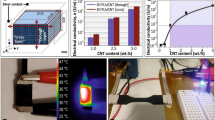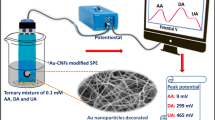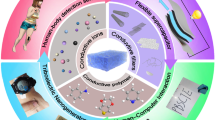Abstract
Wire-like polyaniline (PANI) films were successfully electrodeposited onto an indium tin oxide (ITO) substrate using a pulse galvanostatic method (PGM) in a reverse micelle electrolyte. The as-prepared PANI films were electrochemically analyzed by cyclic voltammetry and electrochemical impedance spectroscopy in 1 mol·L−1 HClO4 solution. It is found that the as-prepared PANI films are highly porous, exhibit the diameters of approximately 100 nm and the lengths exceeding 3 μm, and have favorable electrochemical activities. Furthermore, the as-prepared wire-like PANI films show a good linear relationship of the potentiometric response curve over the pH value range of 3–10 with a slope of 74.13 mV·pH−1 in 0.5 mol·L−1 K2HPO4 basal solutions. The results demonstrate that the prepared wire-like PANI films are promising pH sensors.
Similar content being viewed by others
References
M.A. Seguí, J. Lizondo-Sabater, A. Benito, R. Martínez-Máñez, T. Pardo, F. Sancenón, and J. Soto, A new ion-selective electrode for anionic surfactants, Talanta, 71(2007), No. 1, p. 333.
S. Chandra and H. Lang, A new sodium ion selective electrode based on a novel silacrown ether, Sens. Actuators B, 114(2006), No. 2, p. 849.
R.C. Faria and L.O.S. Bulhões, Hydrogen ion selective electrode based on poly (1-aminoanthracene) film, Anal. Chim. Acta, 377(1998), No. 1, p. 21.
S. Erden, A. Demirel, S. Memon, M. Yilmaz, E. Canel, and E. Kiliç, Using of hydrogen ion-selective poly (vinyl chloride) membrane electrode based on calix [4] arene as thiocyanate ion-selective electrode, Sens, Actuators B, 113(2006), No. 1, p. 290.
M.J. Rodríguez Presa, D. Posadas, and M.I. Florit, Conditioning treatment to improve the potentiometric pH response of polydiphenylamine modified electrodes, Sens. Actuators B, 123(2007), No. 1, p. 142.
S.K. Dhawan, D. Kumar, M.K. Ram, S. Chandra, and D.C. Trivedi, Application of conducting polyaniline as sensor material for ammonia, Sens. Actuators B, 40(1997), No. 2-3, p. 99.
S. Koul, R. Chandra, and S.K. Dhawan, Conducting polyaniline composite: a reusable sensor material for aqueous ammonia, Sens. Actuators B, 75(2001), No. 3, p. 151.
D.S. Dhawale, R.R. Salunkhe, V.S. Jamadade, T.P. Gujar, and C.D. Lokhande, An approach towards the growth of polyaniline nanograins by electrochemical route, Appl. Surf. Sci., 255(2009), No. 19, p. 8213.
Z.M. Tahir, E.C. Alocilja, and D.L. Grooms, Polyaniline synthesis and its biosensor application, Biosens. Bioelectron., 20(2005), No. 8, p. 1690.
G.R. Li, Z.P. Feng, J.H. Zhong, Z.L. Wang, and Y.X. Tong, Electrochemical synthesis of polyaniline nanobelts with predominant electrochemical performances, Macromolecules, 43(2010), p. 2178.
Z. Jin, Y.X. Su, and Y.X. Duan, An improved optical pH sensor based on polyaniline, Sens. Actuators B, 71(2000), No. 1-2, p. 118.
M.M. Ayad, N.A. Salahuddin, M.O. Alghaysh, and R.M. Issa, Phosphoric acid and pH sensors based on polyaniline films, Curr. Appl. Phys., 10(2010), No. 1, p. 235.
A.A. Karyakin, O.A. Bobrova, L.V. Lukachova, and E.E. Karakina, potentiometric biosensors based on polyaniline semiconductor films, Sens. Actuators B, 33(1996), No. 1-3, p. 34.
M. Kaempgen and S. Roth, Transparent and flexible carbon nanotube/polyaniline pH sensors, J. Electroanal. Chem., 586(2006), No. 1, p. 72.
S.Q. Jiao, J.G. Tu, C.Y. Fan, J.G. Hou, and D.J. Fray, Electrochemically assembling of a porous nano-polyaniline network in a reverse micelle and its application in a supercapacitor, IJ. Mater. Chem., 21(2011), p. 9027.
L. Hu, J. Tu, S. Jiao, J. Hou, H. Zhu, and D.J. Fray, In situ electrochemical polymerization of a nanorod-PANI–graphene composite in a reverse micelle electrolyte and its application in a supercapacitor, Phys. Chem. Chem. Phys., 14(2012), No. 45, p. 15652.
V.S. Jamadade, D.S. Dhawale, and C.D. Lokhande, Studies on electrosynthesized leucoemeraldine, emeraldine and pernigraniline forms of polyaniline films and their supercapacitive behavior, Synth. Met., 160(2010), No. 9-10, p. 955.
K. Wang, J.Y. Huang, and Z.X. Wei, Conducting polyaniline nanowire arrays for high performance supercapacitors, J. Phys. Chem. C, 114(2010), No. 17, p. 8062.
Y.G. Wang, H.Q. Li, and Y.Y. Xia, Ordered whiskerlike polyaniline grown on the surface of mesoporous carbon and its electrochemical capacitance performance, Adv. Mater., 18(2006), No. 19, p. 2619.
J.L. Liu, M.Q. Zhou, L.Z. Fan, P. Li, and X.H. Qu, Porous polyaniline exhibits highly enhanced electrochemical capacitance performance, Electrochim. Acta, 55(2010), No. 20, p. 5819.
D.W. Wang, F. Li, J.P. Zhao, W.C. Ren, Z.G. Chen, J. Tan, Z.S. Wu, I. Gentle, G.Q. Lu, and H.M. Cheng, Fabrication of graphene/polyaniline composite paper via in situ anodic electropolymerization for high-performance flexible electrode, ACS Nano, 3(2009), No. 7, p. 1745.
L.L. Zhang, S. Li, J.T. Zhang, P.Z. Guo, J.T. Zheng, and X.S. Zhao, Enhancement of electrochemical performance of macroporous carbon by surface coating of polyaniline, Chem. Mater., 22(2009), No. 3, p. 1195.
Y.H. Lee, C.Z. Chang, S.L. Yau, L.J. Fan, Y.W. Yang. L.Y. Ouyang, and K. Itaya, Conformations of polyaniline molecules adsorbed on Au (111) probed by in situ STM and ex situ XPS and NEXAFS, J. Am. Chem. Soc., 131(2009), No. 18, p. 6468.
Y.L. Xu, J. Wang, W. Sun, and S.H. Wang, Capacitance properties of poly (3,4-ethylenedioxythiophene)/polypyrrole composites, J. Power Sources, 159(2006), No. 1, p. 370.
W.B. Zhong, J.Y. Deng, Y.S. Yang, and W.T. Yang, Synthesis of large-area three-dimensional polyaniline nanowire networks using a “Soft Template”, Macromol. Rapid Commun., 26(2005), No. 5, p. 395.
K. Zhang, L.L. Zhang, X.S. Zhao, and J.S. Wu, Graphene/polyaniline nanofiber composites as supercapacitor electrodes, Chem. Mater., 22(2010), No. 4, p. 1392.
Author information
Authors and Affiliations
Corresponding author
Rights and permissions
About this article
Cite this article
Zhao, F., Jiao, Hd. & Zhao, Sq. Wire-like nano-polyaniline deposited electrochemically in a reverse micelle electrolyte as a pH sensor. Int J Miner Metall Mater 22, 1115–1119 (2015). https://doi.org/10.1007/s12613-015-1175-y
Received:
Revised:
Accepted:
Published:
Issue Date:
DOI: https://doi.org/10.1007/s12613-015-1175-y




